Bautzen, city of the Sorbs (Upper Sorbian spoken - Budyin), city on the Spree, is a "large district city" in Upper Lusatia in the east of Saxony with an interesting history.
Bautzen has an old town worth seeing with important buildings. During a walk in the rain through the city, we got a first impression. "Bautzen is worth a visit. For a long time I thought about whether to show my rain photos or the corresponding sun photos from the internet: See for yourself how the decision turned out.
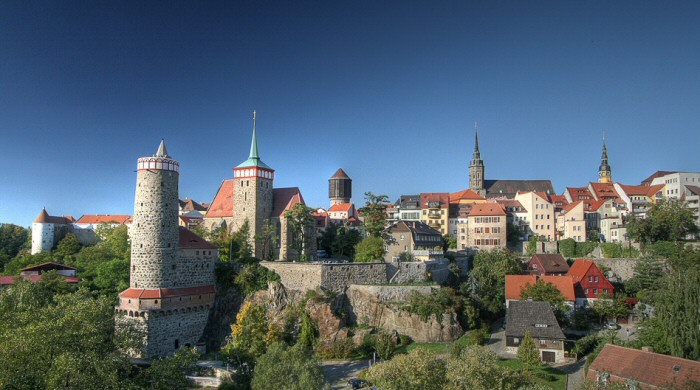
From L. to R.: City fortifications with the tower "Alte Wasserkunst" (1558), St. Michael's Church, water tower in the former Franciscan monastery, Petridom, Town Hall tower.
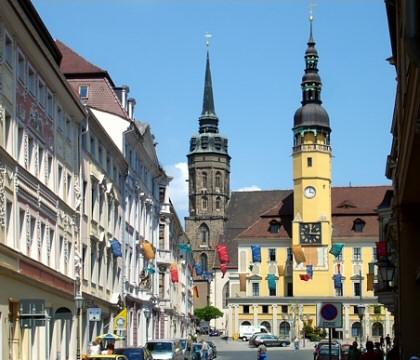
Our hotel is located directly on the main market square next to the town hall. Behind it you can see the Petridom.
From the history of the Petridome (St. Peter's Cathedral):
A first church stood here as early as the year 1000. The collegiate monastery of St. Peter was founded in 1213. With the arrival of the Reformation in Bautzen in 1524, the church was set up as a "simultaneous church" (Catholic service in the choir, Protestant service in the nave). In 1664, the early baroque helmet was placed on the church tower. In 1908, the organ prospect and the galleries were renewed in Art Nouveau style.

The portal to the cathedral chapter. Today, it houses the episcopal ordinariate, the archives (since 1221) and the library (since 1350) of the cathedral chapter, as well as the cathedral treasury (since 1985).

South of the cathedral is the city's baroque town hall, and from the Hauptmarkt you can see the various clocks of the town hall tower. Around the Hauptmarkt is the city's most important Baroque ensemble with various magnificent town houses. The town houses on the western side of Lauenstraße - between the Lauenturm and the town hall - are particularly remarkable and can probably only be found in similar splendour and size in Saxony in Leipzig.
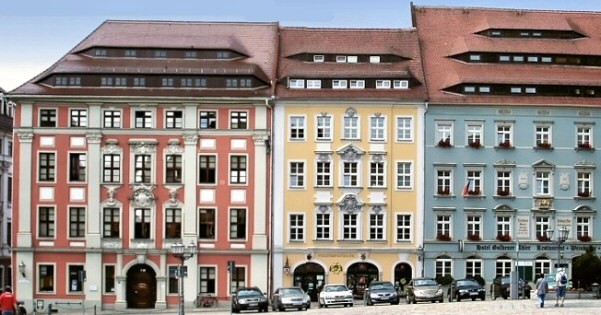
The east side of the main market
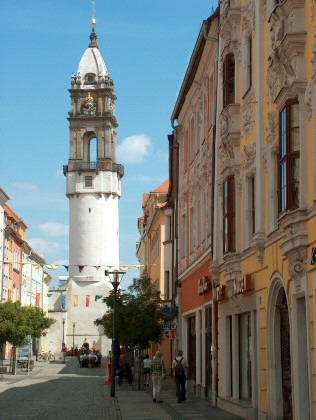
Bautzen is also known as the "city of towers". One of the city's most famous towers is the Reichenturm, also known as the "Leaning Tower of Bautzen".
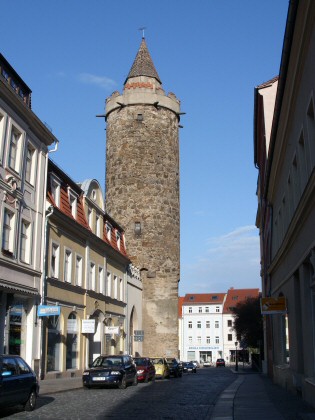
The Wendish Tower from 1566
is the tower of the former Wendish Gate of the city wall, named after a settlement of Wends (Protestant Sorbs) once located here.
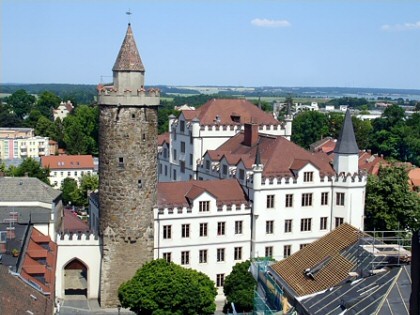
Another view from the Wendish Tower.

The gate tower of Ortenburg Castle at the entrance from Schlossstraße was built in 1483-1486 (reconstruction of the former Matthiastor).
In the late Gothic castle tower there is a St. George's chapel with two high narrow lancet windows on the town side.
The picture shows the striking gate - in the sunshine and if you move the mouse over the picture - in the rain.
The Ortenburg, now used as a court, towers above the town, its white Renaissance gables particularly striking.
In the courtyard of Ortenburg Castle, various outbuildings also house the Sorbian Museum.
King Matthias Corvinus of Hungary (reigned 1458-1490, from 1469 also over Upper Lusatia as a tributary of the Bohemian crown) had Ortenburg Castle renovated in the style of the late Gothic period and also rebuilt the Matthiastor. Until the breakthrough of the New Gate in 1782, the Matthiasturm was the only official access to the castle - with a drawbridge over the moat (filled in 1782).
The town, which slowly developed from an East Germanic settlement, was fought over again and again until the peace treaty between the Holy Roman Empire and Poland was signed in 1018 (Peace of Bautzen). In the following period, the town of Bautzen developed to the east of the castle, which benefited considerably from its location on the crossings of the River Spree on the Via Regia, as well as on the Franconian Road. Bautzen received its town charter in 1213 and subsequently experienced changing ownership. Thus the town belonged at one time to the Ascanians, then to the Bohemians, the Hungarians and finally to the Saxons.
In 1780, the "Voluntary Citizens' Fire Company" was founded. Bautzen thus has the oldest fire brigade in Saxony. In 1813, the Battle of Bautzen (more precisely at Hochkirch; known at the Arc de Triomphe as the Bataille de Wurschen) between the Coalition and the French ends in victory for the Napoleonic troops.
Bautzen is known for its penal institutions. The construction of the Saxon State Penal Institution (Bautzen I) was completed in 1904 and operated as intended. The prison is popularly known as "Das gelbe Elend" (The Yellow Misery) because of the yellow clinker bricks used. The Bautzen II remand prison, which belonged to the local and district court, was built around the same time. During the Third Reich, many political opponents, socialists and communists, but also Jehovah's Witnesses were imprisoned in the town.
During the Second World War, the city suffered great damage. The domes of the Lauenturm and the Michaeliskirche were destroyed and many lives were lost.
With the end of the Second World War, the "Yellow Misery" became one of the special camps of the Soviet secret police. Between 1945 and 1950, at least 2800 people lost their lives.
After the war, Bautzen developed into a scientific and industrial town in the GDR. During this time, many opponents of the regime were imprisoned in the Bautzen prisons. Bautzen II was closed in 1992. Today the former "Stasi prison" serves as a memorial.